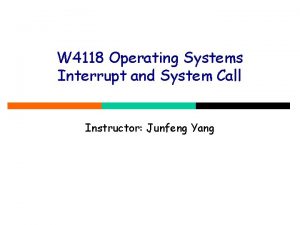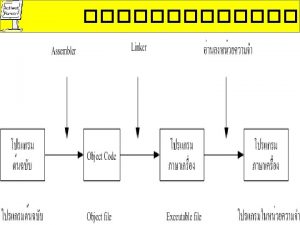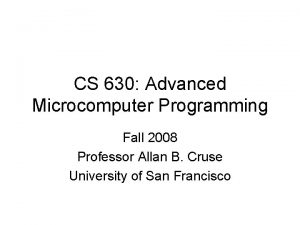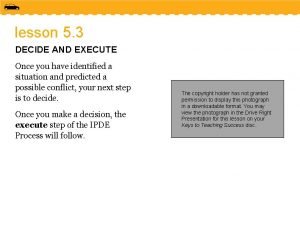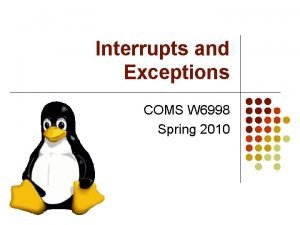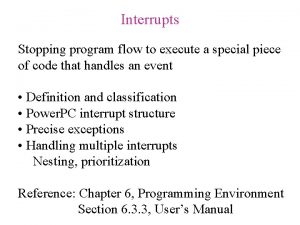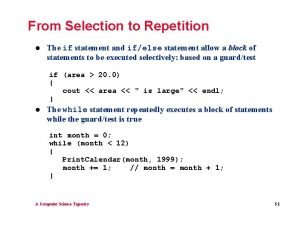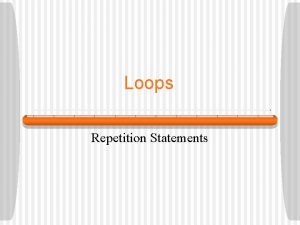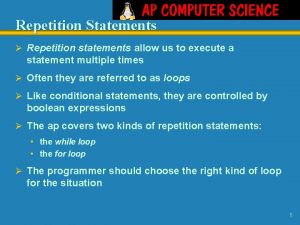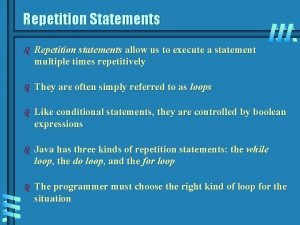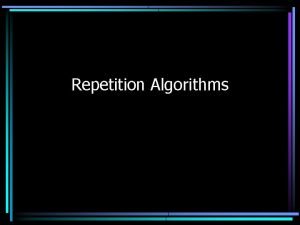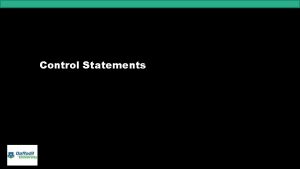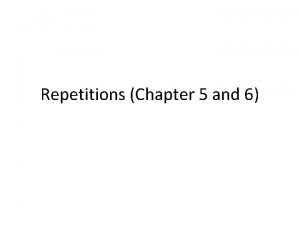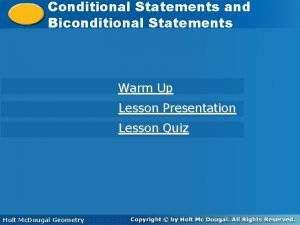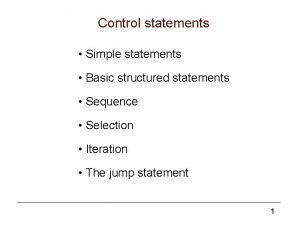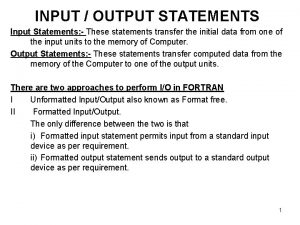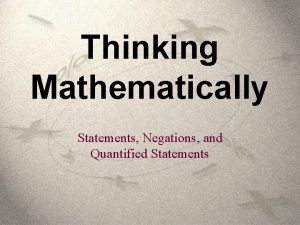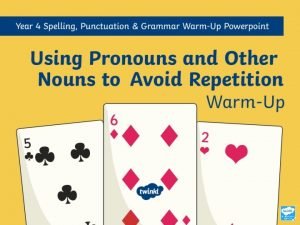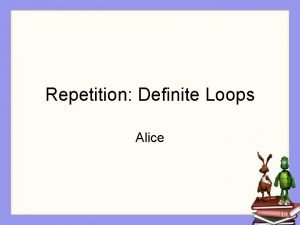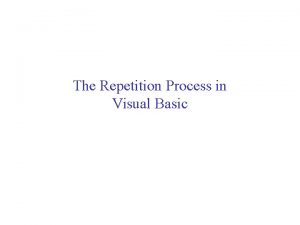Repetition Statements Repetition statements allow us to execute























- Slides: 23

Repetition Statements • Repetition statements allow us to execute a statement multiple times • Often they are referred to as loops • Like conditional statements, they are controlled by boolean expressions • Java has three kinds of repetition statements: – while loop – do loop – for loop • The programmer should choose the right kind of loop for the situation 10/16/2021 CS 101 - Algorithms & Programming I 1

Java Repetition Statements while (condition) statement for ( init; condition; update) statement do statement while (condition); where • statement is any Java statement • condition is a boolean expression 10/16/2021 CS 101 - Algorithms & Programming I 2

while Statement • The most general one of these loop statements is while ( boolean-expression ) statement where statement can be any statement including a compound statement, an if-statement, another loop statement, . . . • Statement is repeated as long as the condition (boolean-expression) is true. When the condition gets false, the statement is not executed anymore. • If the condition never gets false infinite loop • If the condition gets immediately false the loop will be repeated zero times. 10/16/2021 CS 101 - Algorithms & Programming I 3

while Statement – Flow Diagram while ( condition ) statement condition true statement false 10/16/2021 CS 101 - Algorithms & Programming I 4

while Statement – Counter Controlled Loop(1) • Print 5 asterisk characters • This loop will be repeated for 5 times (count: 0, 1, . . . , 4) count = 0; while ( count < 5 ) { System. out. println( “*”); count = count + 1; } System. out. println( “done”); 10/16/2021 CS 101 - Algorithms & Programming I * * * done 5

while Statement – Counter Controlled Loop(2) • Read & sum 5 values sum = 0; count = 0; while ( count < 5 ) { value = scan. next. Int(); sum = sum + value; count = count + 1; } System. out. println( “sum is ” + sum); 10/16/2021 CS 101 - Algorithms & Programming I 5 3 7 4 1 sum is 20 6

Counter Controlled Loops • Template of counter-controlled loops initialize counter while ( condition depending on counter) { other statements to be repeated update counter } 10/16/2021 CS 101 - Algorithms & Programming I 7

Infinite Loops • The body of a while loop eventually must make the condition false • If not, it is called an infinite loop, which will execute until the user interrupts the program – in console aapplications use Ctrl-C to exit • This is a common logical error • You should always double check the logic of a program to ensure that your loops will terminate normally int count = 1; while (count <= 25){ System. out. println (count); count = count - 1; } 10/16/2021 CS 101 - Algorithms & Programming I 8

Infinite Loops (2) i = 1; while ( i != 50 ) { System. out. println( i); i = i + 2; } System. out. println( “done”); i = scan. next. Int(); while ( i != 1 ) { if ( i % 2 == 0) i = i / 2; else i = 3 * i + 1; } System. out. println( “done”); 10/16/2021 CS 101 - Algorithms & Programming I Sometimes, it is difficult to check loop terminating condition. 9

Sentinel-Controlled Loops • What happens if we don’t know how many times a loop will run. • Ex: a loop which reads the scores of the students in an exam and find the average of the scores; and we we don’t know the number of students. How are we going to stop the loops? use a sentinel-value • We choose a sentinel-value which can not be a score (e. g. – 1) • We read the scores until this sentinel-value has been entered. When this sentinel-value has been read, we stop the loop. 10/16/2021 CS 101 - Algorithms & Programming I 10

Sentinel-Controlled Loops – Example(1) int sum = 0; int num. Of. Students = 0; int ascore; double avg; System. out. print(“Enter a score (-1 to stop) >”); ascore = scan. next. Int(); while (ascore != -1) { sum = sum + ascore; num. Of. Students = num. Of. Students + 1; System. out. print(“Enter a score (-1 to stop) >”); ascore = scan. next. Int(); } avg = (double) sum / num. Of. Students; System. out. println(“The number of students : “ + num. Of. Students); System. out. println(“Average Score : “ + avg); 10/16/2021 CS 101 - Algorithms & Programming I 11

Example Program 1 // This program finds the factorial value of the given positive integer import java. util. Scanner; public class Factorial { public static void main(String[] args){ int num, fact. Val, counter; // Create a Scanner object Scanner scan = new Scanner(System. in); // Read the positive integer System. out. print("A Positive Integer: "); num = scan. next. Int(); // Find its factorial value counter = 2; fact. Val = 1; while (counter <= num) { fact. Val = fact. Val * counter; counter = counter + 1; } // Write the result System. out. println("Given Positive Integer: " + num); System. out. println("Its Factorial value : " + fact. Val); } } 10/16/2021 CS 101 - Algorithms & Programming I 12

for Statement • Another loop statement in Java is for-statement. • for-statement is more suitable for counter-controlled loops. for ( initialization ; condition ; increment ) statement which is equivalent to initialization ; while (condition ){ statement ; increment ; } 10/16/2021 CS 101 - Algorithms & Programming I 13

for Statement – Flow Diagram initialization condition false true statement increment 10/16/2021 CS 101 - Algorithms & Programming I 14

for statement -- Example int i; int sum = 0; for (i=1; i<=20; i++) sum = sum + i; int i; int sum = 0; i = 1; while (i<=20) { sum = sum + i; i++; } int i; int sum = 0; for (i=100; i>=1; i--) sum = sum + i; int i; int sum = 0; i = 100; while (i>=1) { sum = sum + i; i++; } 10/16/2021 CS 101 - Algorithms & Programming I 15

for statement -- Example int i, j; int count=0; for (i=1, j=10; i<j; i++, j--) count++; count is 5 int i, j; int count=0; i=1; j=10; for (; i<j; ) { count++; i++; j--; } 10/16/2021 CS 101 - Algorithms & Programming I 16

do-while statement • The third loop statement in Java is do-while statement. do statement while ( condition ) ; which is equivalent to statement while (condition ) statement 10/16/2021 CS 101 - Algorithms & Programming I 17

do-while statement – Flow Diagram statement true condition false 10/16/2021 CS 101 - Algorithms & Programming I 18

do-while statement -- Example int i=1; do { System. out. println(i); i++; } while (i<10); String s; do { System. out. print(“Enter a word > “); System. out. flush(); s = scan. next. Line(); System. out. println(s); } while (! s. equals(“quit”)); 10/16/2021 CS 101 - Algorithms & Programming I 19

Nested Loops • If the body of a loop contains another loop, this is called as a nested loop. int sum=0; int i, j; for (i=1; i<=5; i++) for (j=1; j<=6; j++) sum=sum+1; sum is 5*6=30 int sum=0; int i, j; for (i=1; i<=5; i++) for (j=1; j<=i; j++) sum=sum+1; sum is 1+2+3+4+5=15 10/16/2021 CS 101 - Algorithms & Programming I 20

Nested Loops – Example 1 a right angled triangle (n lines, ith line contains i stars) * ** ***. . * 10/16/2021 for (i=1; i<=n; i++) { // for each line for (j=1; j<=i; j++) System. out. print(“*”); System. out. println(“”); } CS 101 - Algorithms & Programming I 21

Nested Loops – Example 2 • a triangle shape (1 st line contains 1 star, 2 nd line contains 3 star, . . . , nth line contains 2 n-1 stars) * *****. . *** 10/16/2021 for (i=1; i<=n; i++) { // for each line for (j=1; j<=(n-i); j++) System. out. print(“ ”); for (j=1; j<=(2*i-1); j++) System. out. print(“*”); System. out. println(“”); } CS 101 - Algorithms & Programming I 22

Nested Loops • Nesting can be more than one level int sum=0; for (i=1; i<=5; i++) for (j=1; j<=5; j++) for (k=1; k<=5; k++) sum=sum+1; 10/16/2021 CS 101 - Algorithms & Programming I sum is 125 23
 Execute elf file
Execute elf file Failed to execute 'fetch' on 'window': failed to parse url
Failed to execute 'fetch' on 'window': failed to parse url Fetch execute cycle adalah
Fetch execute cycle adalah System call
System call A loop that continues to execute endlessly is called
A loop that continues to execute endlessly is called Steps of instruction cycle
Steps of instruction cycle Addw -8(%bp), %ax
Addw -8(%bp), %ax Java statement execute
Java statement execute Spare or execute alba
Spare or execute alba Fetch execute cycle
Fetch execute cycle Execute plan b
Execute plan b Lane positions
Lane positions Fetch decode execute cycle steps
Fetch decode execute cycle steps Buffer overflow
Buffer overflow Stored procedure firebird
Stored procedure firebird Fetch execute cycle
Fetch execute cycle Program flow control with interrupts
Program flow control with interrupts Fetch decode execute cycle steps
Fetch decode execute cycle steps He sends romeo into exile.
He sends romeo into exile. Fetch decode execute memory writeback
Fetch decode execute memory writeback Excel vba execute stored procedure
Excel vba execute stored procedure Bandwagon propganda
Bandwagon propganda 6561x6561
6561x6561 Repetition statements in java
Repetition statements in java



